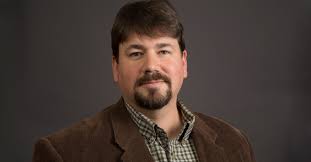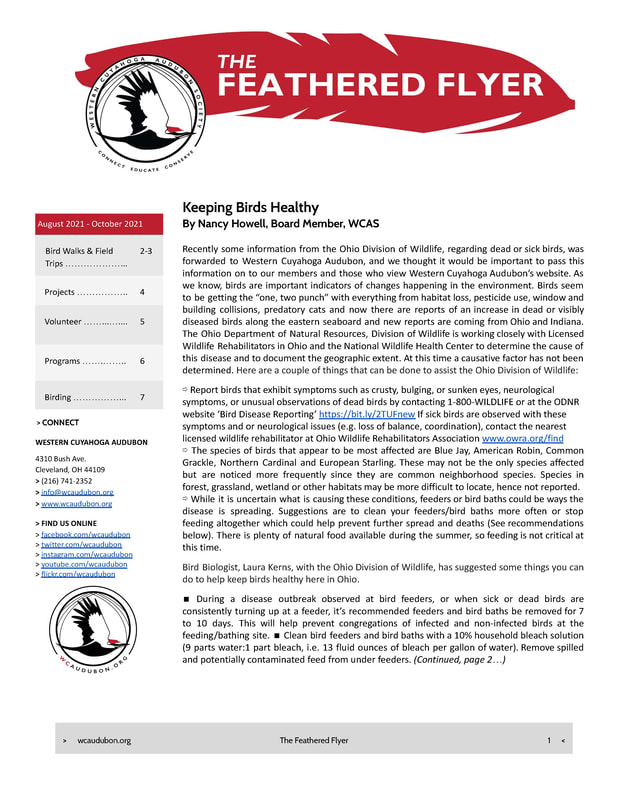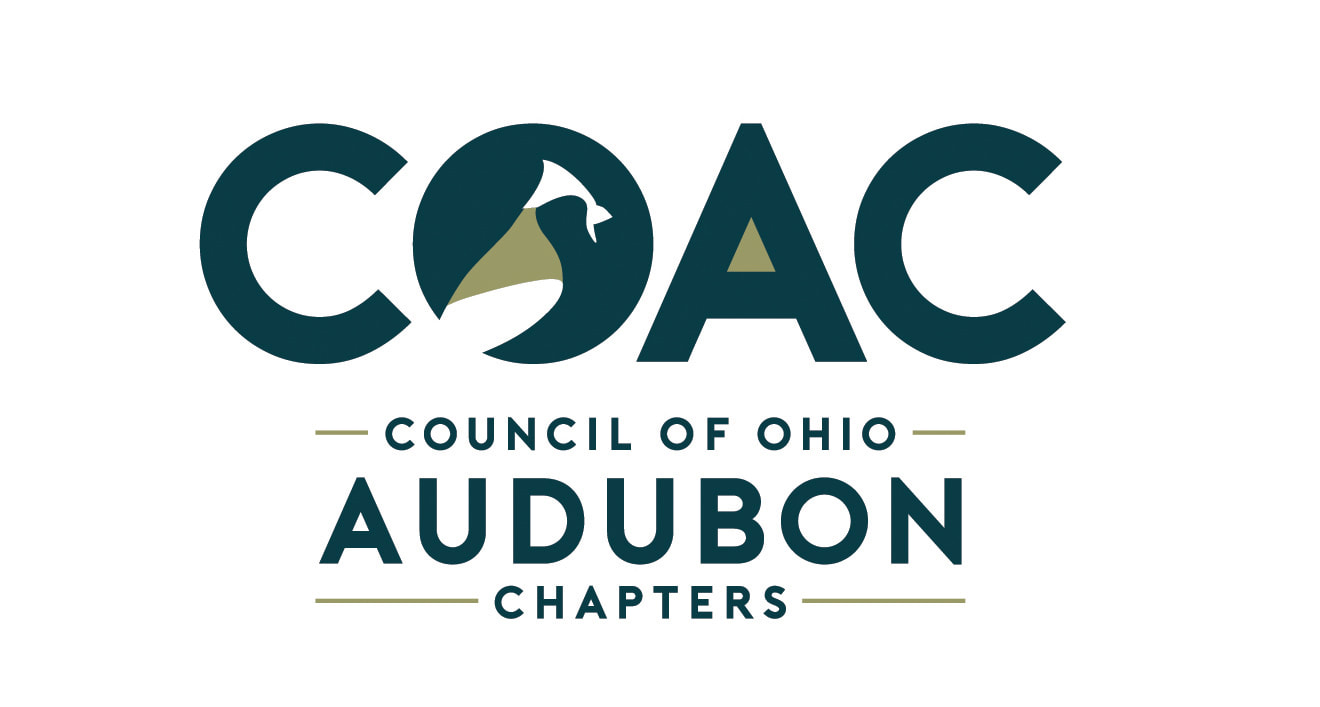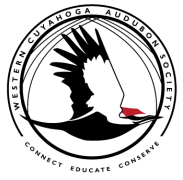Dr. Andy Jones talks about a lifetime dedicated to the natural sciences, how collecting for data and diversity solves problems, and the value of research through a climate change lens.
Introduction
Nancy Howell: Hi, I’m Nancy Howell with Western Cuyahoga Audubon and I’m also an employee here at the Cleveland Museum of Natural History and it is my pleasure of introducing Dr. Andy Jones, who is the Curator and Head of Ornithology at the Museum and also the Director of Science at the Museum. I’m going to let Andy talk a little bit about how he got involved with ornithology, birds, interests, at a young age. From Early Years to Young Scientist Dr. Andy Jones: I started at a very young age, I wrote my first field notes when I was five years old. I went out in the yard and counted Fowler’s Toads, and wrote them down, and my Dad was teaching me to keep track of things. I grew up in Raleigh, North Carolina. I actually started with reptiles, amphibians, and that was after getting out of dinosaurs which I started at age three or four, which a lot of kids do. And I took a kind of circuitous route. I started with dinosaurs, reptiles and amphibians and then fish took over. By middle school I had thirteen aquarium in my bedroom - and that was a second floor bedroom, so we were concerned we would come home and my bedroom would be on the first floor but that never happened! I was keeping things that I would buy in the nearby store and well as stuff I would find in the nearby creeks and I started getting really interested in what’s in the backyard. By high school I had to do a wildflower project which I was not really excited about and ended up really enjoying it and had to identify twenty-five species of wildflowers. While I was doing that a raptor flew over and I started yelling, “Hey, there’s a Bald Eagle!” My Dad went along with me and said, “Yeah, it’s a Bald Eagle.” My young cousin who was maybe ten at the time said, “No, that’s an Osprey.” I thought, “I’m not really sure what an Osprey is, but it had a white head so it must be a Bald Eagle”. I looked it up later and actually it had a black line and a white head and he was right. That was the first bird I’d officially paid attention to, that was maybe my freshman year in high school and I got really hooked from there and I started birding in the backyard and started seeing what else was around and it totally snowballed from there. Natural History and Genetics So, natural history really grabbed me early. In college I started taking classes in genetics and I thought that that was some very interesting stuff too. I started reading more about genetics and seeing that that could lead to telling you why one species would be split into two, or why a genus name might change or a common name might change. Since I was keeping fish as a kid, I kept seeing fish names change in magazines and I wondered why that was. And then when I started getting into birds, I saw my field guides changing and so in my mind I started putting the genetics together with the questions I had over changing names and that is this current obsession with genetics. Nancy Howell: That seems to be the way it’s going in genetics, to see who is related to whom. Cleveland Museum of Natural History Bird Collections Nancy Howell: Now, you have collections. How many birds are in the Cleveland Museum of Natural History’s collection? Dr. Andy Jones: We have about 35,000 specimens and about 30,000 of those are what we call “round skins”. That is where you essentially take everything out of a bird and put cotton inside, sew it up, and you don’t pose it like taxidermy, you lay it on its back. That is where you open up a cabinet and there might be a tray of one hundred Back-capped Chickadees all laying on their backs. They have tags attached to them which give the data which is what makes them really important for us for research. So, the vast majority of the collection is round skins and then we have a few thousand compete skeletons. We actually have a group of Dermestid beetles that live in the basement, that you’ve seen, that strip all the meat off of the skeletons and once they’re clean, we can save a complete skeleton for research. We also have a few thousand eggs and nests. Nancy Howell: What about the birds that are mounted, poised, with eyes, is that in the equation? Dr. Andy Jones: Technically, it’s not. If you walk through the building, what you see for the public is taxidermy mounts that usually don’t have any data associated with them. We help curate them but they are under the purview of our exhibits folks. Those are mounted for aesthetic and education reasons and a researcher couldn’t do a whole lot with them. We have a few ‘edge’ cases, we have a few birds collected in the 1920’s and they were posed in a life-like way and have a tag attached to them. They are actually valuable for research and they still look great for exhibits too. Nancy Howell: And do you get collections in from other organizations? There are some colleges that may have donated as well. Dr. Andy Jones: Yes, so our collections do grow and some of that is through donations. Our most significant growth recently that way was from the Kingman Museum in Michigan. They are a smaller museum and they decided it doesn’t make sense for them to have a thousand research specimens, so they donated their whole collection to us. Occasionally someone is cleaning out their attic of their parents or grandparents and they suddenly find ten Grouse or something up there and if they’ve been mounted with data that is actually something we do take. A lot of times, they’re just dusty and don’t have much data and they’re not for us. What’s The Purpose of the Bird Collections? [00:05:54] Nancy Howell: So, we get people curious about, “Well, why did they have to kill the birds?” “Why are there so many Chickadees in a drawer?” “Why can’t they take photographs?” What’s the purpose of the bird collections and how are they used here and by somebody else? Dr. Andy Jones: We’re here to document diversity. We’re here to document today’s diversity and we’re also here to document the history of diversity. We have House Sparrows in our collection. People don’t get very excited about House Sparrows but we have House Sparrows from the last few years and we have House Sparrows from the early 1900’s. If you lay them in a tray side by side, you can obviously see the hundred-year-old ones because they were keeping warm by getting up against buildings and the soot from the buildings just covers them in a dusky layer of junk. That tells you a little bit about changing air conditions and climate conditions. We have been talking with a student who’s been wanting to come by and take like a piece of scotch tape and stick it to some of the feathers, and peel off that particulate matter, and then they can actually put it under a microscope and quantify the kinds of gunk that was getting into the House Sparrows. Nancy Howell: And people too! So we can see what people were breathing in! Dr. Andy Jones: That’s one little example of the kind of work that can be done with specimens but we can’t do that with just five specimens. We need lots of individuals within a species and so the Black-capped Chickadee example I think is a good one. We have probably three or four hundred Black-capped Chickadees in our collection. Some of those are very recent and some go back more than one hundred years. We can use them to look at change through time in the species. We also look at changes from place to place. So we have them not just from the Cleveland area but from Michigan, Minnesota, Colorado, North Carolina, and just like people don’t look the same from place to place, Black-capped Chickadee do not look the same as you go from place to place. Nancy Howell: That’s interesting because you look at a Field Guide and you look at the bird and, “That’s a Black-capped Chickadee!” - they all look the same. Dr. Andy Jones: Yes, they do on first brush, but when you start looking at them and a lot of times we’re doing more specific measurement and a lot of our Black-capped Chickadees we’ve actually cut a wing off the specimen and spread it open, it dries out like that, and you can measure every single feather on the bird to look at dispersal ability. If you have a long pointed wing you can disperse a long way. If you don’t have that kind of wing, you don’t disperse as far. We want to show changes through time, we want to show variation from place to place, and we also want to preserve this because we don’t know how people will use these specimens later. My favorite story is the Peregrine Falcon story with the DDT, DDE and dieldrin where these pesticides were introduced into the system and eventually that made its way into the prey based Peregrines. That interfered with their ability to put calcium into bone structure as well as their eggshells. So when they try and incubate their eggs, they were cracking their eggs open in the mid-1900’s. So, we had kind of a smoking gun story right? The DDT, thinner eggshells but we needed to go to a natural history museum to show there truly was a thinning of eggshells through time. So, we needed eggshells from the late 1800’s, the early 1900’s, and the mid-1900’s. Researchers did that, they went to natural history museums, pulled these eggshells and measured how thick they were and that showed absolutely the eggshells were the same thickness for decade after decade and then all of a sudden you introduce these pesticides and the eggshells got thinner. Some poor researcher had to climb down the face of a cliff in the 1800’s to retrieve one of these eggs and they were doing that for a research project that took place decades after they themselves passed away. They were studying a technology that didn’t exist yet. Every time we prepare a specimen we think this could be really important for a project tomorrow or one hundred years from now. How is Climate Change Affecting Birds? [00:10:32] Nancy Howell: How is climate change affecting birds? Are you seeing any differences with bird movements? Birds staying here certain times of the year? How does climate change seem to be affecting certain species? Dr. Andy Jones: It depends on the kind of bird we’re talking about. There are responses happening. If you’re a bird like a Song Sparrow or an Eastern Phoebe, you might migrate a few hundred miles. The weather you experience in the winter is probably related to the weather you’re experiencing in the breeding ground. So, whatever is happening in the Cleveland weather is not too far off from what’s happening in Kentucky or Tennessee. So, if we get an early spring here, that’s going to be also be something they can detect on their wintering ground. So they migrate earlier in the spring. They can respond to changing climate conditions. If you’re a long distance migrant who’s going to Central or South America, like a Blackburnian Warbler, whatever you’re experiencing in December or January has nothing to do with what is happening in Cleveland, Ohio. They cannot change their behavior based on the weather they experience that winter. They have to have a genetic change that changes what day they migrate north again. That’s asking a lot. That’s asking alot of genetic change in a lot of species and climate change is getting faster. Nancy Howell: So genetic change is not going as fast. You have to go through generations. Dr. Andy Jones: And so we’re seeing mismatches. We’re seeing some of these birds are coming back a little earlier in the spring, but not early enough. That means that the insects have already exploded in spring and early summer and they sort of reach a peak and the babies need to be hatching right at that time so there’s lots of food out there. But if the birds haven’t returned early enough, the food has already reached its peak and started dropping off and so they raise fewer young. That’s been shown definitively in several Flycatchers in Europe. Nancy Howell: That is really interesting. It’s amazing how everything is so tied together. The plants, the insects, the birds, the weather, the climate. That’s what I love about the biology: it’s so tied together that once you start changing something everything seems to go kaflooey. Think Global Act Local [00:13:04] Nancy Howell: What words would you have for somebody who is maybe not so much into birds? How can we protect them? What would be the best thing for us, just a person in the neighborhood? Andy Jones: It’s still the “think global act local”. I think this is a great mantra. Climate change is a global problem. We can’t all go and have global solutions, we’re going to have to do things in our neighborhood. Some of that can be really simple things depending on the bird you care about. If you’re like me, you think Woodpecker’s are just the coolest thing around! I have a half-dead Oak in my yard, and I’m leaving it alone. It is food for Woodpeckers. That is a really basic level thing right but there are bigger picture things like recycling, buying recycled products as much as you can, thinking about your own diet - you want to minimize your impact on the earth as much as you can. You have to research every decision you’re making at this point. What you’re buying, how you’re using it and what you’re throwing away. Everything’s got an impact. What’s the Biggest Bird in the Museum’s Collection? [00:14:28] Nancy Howell: What’s the biggest bird in the museum collection? Andy Jones: The biggest bird is an Ostrich. We have a full specimen. It would be too large to fit into our cabinets. When they prepared the bird they actually folded the legs underneath it and put the head on top it’s a very weird looking Ostrich but it was the only way we could preserve it. It’s from the Cleveland Zoo. When the birds pass away at the Zoo or the local rehab centers, they freeze them and give them to us so we can still make research. Nancy Howell: As long as there’s data. [00:15:09] Nancy Howell: How about the smallest? Andy Jones: We have Hummingbirds from all over the Americas. We do not have the Cuban Bee Hummingbird. We have a few that are closely related to it though and they are ridiculously tiny. Actually, we restored one of them in the cabinet with the Ostrich. So when I show people the collection I can show people the little Hummingbird next to the Ostrich. Nancy Howell: That’s fantastic. You have that huge diversity from the huge Ostrich to the littlest things like the Hummingbirds and the Kinglets. Is there anything else you’d like to share? Research in the Context of Climate Change [00:16:04] Andy Jones: Climate change is the overarching problem that dominates what we think about right now. I am interested in taxonomy and systematics because I want to know how many species of birds there are in the world and where they occur. If we want to preserve them then we have to know the basics: how many there are and where they are. Climate change is making all of this more complicated because things are kind of shifting around. But that’s not the only issue. We have to think about habitat loss and lots of other local management issues. My answer is there’s a lot of interrelated, complicated problems and a lot of this relies on people keeping up with the news and paying attention to local, what impacts are happening in your city and your county and your voice is something that can really help change the way things are being managed. How Do You Get Your Research Out to the Public? [00:16:59] Nancy Howell: How do you get your research out to the public? Andy Jones: When I complete a study it has to go through peer-review process. If I make a new discovery or describe a new pattern that goes to a journal to get reviewed by scientists. If it is approved, revised, and eventually published, once that happens it’s out it’s out for the academics of the world to see which is not the full audience we’re after. We have a great relationship with our marketing and communications staff at the Museum and we publish a member magazine called “Highlights” of all the research happening at the Museum. Depending on the nature of the work, we may also start to do press releases and putting things out for local papers and Internet science sites as well. Nancy Howell: I know you do programs for local organizations too. That may not be lucrative but it gets the information out to the public. Andy Jones: I’m a birder as well as an ornithologist so I know a lot of the birding groups in the region and I’ve spoken to a lot of societies in northern and central Ohio and worked a lot with the Ohio Ornithological Society and other groups. I give a lot of public lectures I think it’s important and I like doing it. Nancy Howell: Birds are very much a part of our environment and are the “canaries in the coal mine” as far as figuring things out and we’ve already learned a lot about how our environment is changing and how we might be able to protect it and we still need to do more. I’m hoping we can all do that little bit around your neighborhood. Download: Ornithology in a Shifting Natural World with Dr Andy Jones, Cleveland Museum of Natural History Dr. Andy Jones. Photo by Laura Dempsey. Dr. Andy Jones. Photo by Laura Dempsey.
Dr. Andy Jones is Curator of Ornithology at The Cleveland Museum of Natural History. He is the first person hired as the William A. and Nancy R. Klamm Endowed Chair of Ornithology (in 2006), thanks to a major donation from the Klamms to the museum. In 2011, he was named Director of Science, overseeing all activities in the Collections & Research Division.
Dr. Jones received his BS in Biological Sciences from the University of Tennessee at Knoxville, and his PhD in Ecology, Evolution, and Behavior from the University of Minnesota. He originally hails from east Tennessee, where his passion for natural history began at an early age; his current research involves the evolutionary history of birds from around the world. Dr. Jones is responsible for the Museum’s collection of avian specimens, which consists of approximately 30,000 study skins and 4,000 egg sets from the Ohio region and western North America as well as approximately 1,000 osteological specimens from Ohio. He is also responsible for specimen acquisition and preservation, maintenance of specimen records, and carrying out original research. His other tasks include providing various services to the scientific community, the media, the Museum’s exhibitions and education divisions as well as the public at large. Dr. Jones was among 14 prominent American ornithologists to be named an elective member of the American Ornithologists' Union in 2009, and he has served as Secretary of the American Ornithologists' Union since 2014.
Make A Donation to Western Cuyahoga Audubon. Your gifts guarantee chapter activities, programs and research continues to reach members and connect birding conservationists around the world. Use our safe and secure PayPal payment button below to make a donation of any amount you choose. All donations are gratefully received.
Comments
|
Story BlogThe Feathered Flyer blog publishes human interest stories about birding and habitat conservation. After watching, ‘My Painted Trillium Quest' by Tom Fishburn, Kim Langley, WCAS Member said, “Wonderful! It was a lift just knowing that such a site exists and is being protected!”
Media LibrariesQuarterly NewsletterSTORIESPodcastsWCAS is a proud member of The Council of Ohio Audubon Chapters (COAC) and promotes chapter development by sharing the best practices, brainstorming solutions to common problems, and building relationships in workshops and retreats. Subscribe
VideosYouth
Advocacy
Clean Energy
Reporting
Awards
Volunteerism
Take ActionResourcesBlogsArchives
October 2023
Categories
All
|
EDUCATENews Blog
Monthly Speakers Field Reports Bird Walk Reports Christmas Bird Count-Lakewood Circle Media Library Newsletter Archive Education Resources STORE |
Western Cuyahoga Audubon Society
4310 Bush Avenue Cleveland, Ohio 44109 [email protected] Western Cuyahoga Audubon Society is a 501(c)(3) nonprofit organization. Your donation is tax-deductible. The tax ID number is: 34-1522665. If you prefer to mail your donation, please send your check to: Nancy Howell, Western Cuyahoga Audubon Treasurer, 19340 Fowles Rd, Middleburg Hts, OH 44130. © 2020 Western Cuyahoga Audubon Society. All rights reserved. Privacy Policy | Terms of Use | Legal | Store Shipping Rates | Site Map |









 RSS Feed
RSS Feed

